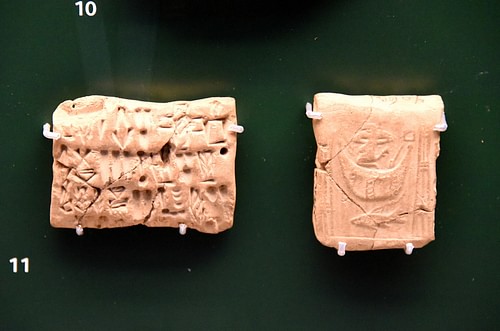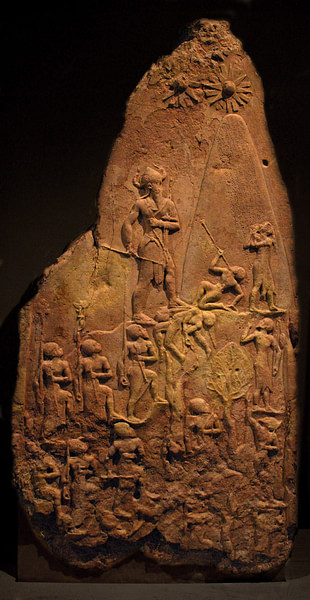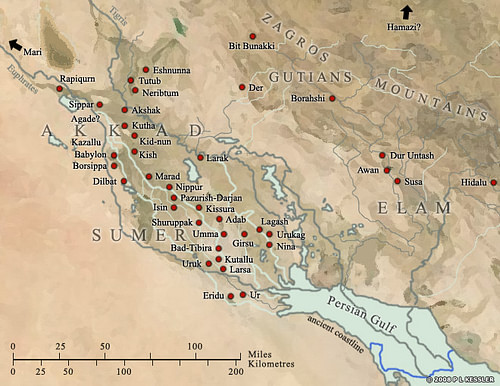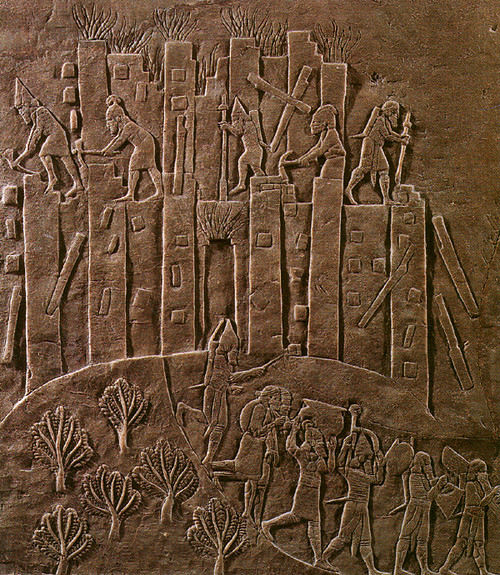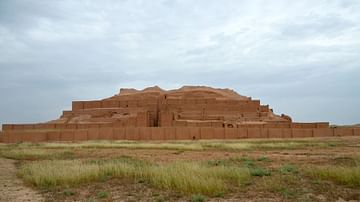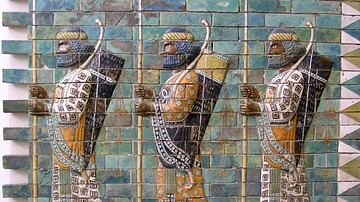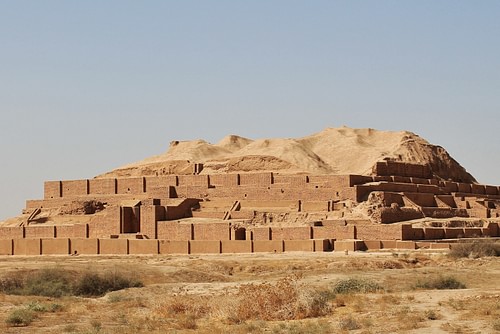
Elam was a region in the Near East corresponding to the modern-day provinces of Ilam and Khuzestan in southern Iran (though it also included part of modern-day southern Iraq) whose civilization spanned thousands of years from c. 3200 - c. 539 BCE.
The name comes from the Akkadian and Sumerian for “highlands” or “high country” while the Elamites referred to their land as Haltami (or Haltamti) which seems to have had the same meaning. The Bible (Genesis 10:22) claims the region is named for Elam, son of Shem, son of Noah but this has no support outside of the biblical narrative.
Their language corresponds to no others and has yet to be deciphered so their early history comes from Mesopotamian sources. This applies only to Elamite linear script, however, as their language was preserved in cuneiform script after their contact with the Sumerians.
The origin of the Elamites is considered as mysterious as their language, but they were most likely the indigenous people of the Iranian Plateau whose culture first began to develop during the Mesopotamian Ubaid Period (c. 5000-4100 BCE). Their civilization has been divided by scholars into different periods:
- Proto- Elamite Period (c. 3200 - c. 2700 BCE)
- Old Elamite Period (c. 2700 - c. 1600 BCE)
- Middle Elamite Period (c. 1500 - c.1100 BCE)
- Neo-Elamite Period (c. 1100 - c. 539 BCE)
The conclusion of Elamite civilization is given to correspond to the early years of the Persian Achaemenid Empire (c. 550-330 BCE) after the region was conquered by the first Achaemenid king Cyrus II (the Great, r. c. 550-530 BCE) but Elamite culture continued to exert significant influence over the Achaemenids as evidenced by later Elamite written language (given in cuneiform script) used as one of the three languages of the Behistun Inscription of Darius I (the Great, r. 522-486 BCE). The Elamite pantheon seems to have also influenced ancient Persian religion prior to the establishment of Zoroastrianism in the region.
Much of the ancient documentation regarding Elam comes from Akkadian, Sumerian, and Assyrian texts and periodic mention in the Bible. According to the inscription of the Neo-Assyrian king Ashurbanipal (r. 668-627 BCE), he conquered and thoroughly destroyed the cities of Elam c. 647-646 BCE, but archeological evidence has proven that claim an exaggeration as Elamite cities, and culture, continued afterwards.
The Elamites were never a cohesive ethnic group but rather a federation of disparate peoples living in a specific region under the leadership of different cities such as Awan, Anshan, Shimashki, and Susa. Artifacts, primarily from Susa, give evidence of extensive trade relations as far east as India, and the Elamites were the conduit for trade between Mesopotamia and all points east. Elam reached its height during the Middle Elamite Period when it expanded its political power to establish the Elamite Empire.
Among the most famous kings of the Elamites were Untash-Napirisha (r. c. 1275-1240 BCE) who built the ziggurat and temple complex of Dur Untash (Chogha Zanbil) as well as over 50 other structures, and Shutruk-Nakhkunte (r. 1184-1155 BCE) who founded the short-lived Elamite Empire. Elam declined after joining the coalition of Medes, Babylonians, and others who toppled the Neo-Assyrian Empire which elevated Media to supremacy in the region. Median rule was then replaced by the Persians under Cyrus II and, afterwards, Elam remained a part of successive empires until the fall of the Sassanian Empire in 651 CE to the Arab Muslims.
Proto-Elamite Period
Little is known of the so-called Proto-Elamite Period because its history is given in the as-yet undeciphered linear script. The proto-Elamite script was developed sometime around 3200 BCE and remained in continuous use until c. 2700 BCE when contact with Sumer introduced cuneiform script. The details of this era, therefore, are vague. Scholar F. Vallat comments:
Elamite history remains largely fragmentary. Because there are few indigenous sources, attempts at reconstruction must be based primarily on Mesopotamian documentation. By far the largest proportion of the known Elamite texts have been excavated at Susa, a city that, from its foundation c. 4000 BCE, alternated between subjection to Mesopotamian and Elamite power. (Encyclopedia Iranica, 2)
Based on artifacts found at Susa (primarily) and elsewhere, the Elamites were already skilled artisans at this time, creating exceptional ceramics and other works which have no relation to neighboring states. Elam enters the historical record via Sumerian historical texts in c. 2700 BCE which give an account of the first war in recorded history. The Sumerian king Enemebaragesi of Kish defeated the Elamites in battle and brought back rich spoils of war to Sumer. The account of Enemebaragesi's victory is given in the Sumerian King List and this brief mention is the beginning of known Elamite history.
Old Elamite Period
Elamite culture was already well established by the time of the beginning of the Old Elamite Period but was fully developed by the dynastic houses which ruled from Awan, Anshan, and Susa, respectively, at different times during this era. Although Awan and Anshan were once considered two different cities, modern-day scholars believe Awan was simply the older name of the royal city which became Anshan. As with almost all aspects of Elamite history, the following dates for the dynasties are approximations:
Awan Dynasty (c. 2350 - c. 2150 BCE) – the first historically attested dynastic house which developed pre-existing trade contracts with Mesopotamian city-states and others to the east. Sargon of Akkad (r. 2334-2279 BCE) conquered Awan during the reign of the 8th king, Luh-Ishan (r. c. 2300 BCE), and took Susa. The Akkadians held both royal cities and influenced the language and culture, furthering the use of cuneiform script in the region which had begun with the Sumerians. Sargon's grandson, Naram-Sin (r. 2261-2224 BCE) concluded a peace treaty with Elam after putting down rebellions in the region and from his Victory Stele scholars have learned the names of many of the Elamite gods, rulers, and other aspects of Elamite history. When the Akkadian Empire fell to the Gutians, the Awan Dynasty reasserted control over Awan and Susa but then collapsed when the Gutians invaded their region.
Shimashki Dynasty (c. 2200-1900 BCE) – best known for their conflict with the Sumerian city of Ur during the Ur III Period (2047-1750 BCE). The king of Ur, Ur-Nammu (r. 2047-2030 BCE) drove the Gutians from Sumer and they were later conquered and driven from Elam by his son Shulgi of Ur (r. 2029-1982 BCE). Shulgi then took Susa and established a firm Sumerian presence in the region which lasted until the reign of Ibbi-Sin (r. c. 2027-2004 BCE) when a coalition of Elamites and Amorites sacked Ur and took Ibbi-Sin prisoner. The Elamites thereby ended Sumerian control in the region which ultimately resulted in Sumerian decline and disappearance from the historical record.
Sukkalmah Dynasty (c. 1970 - c. 1770 BCE, also known as the Epartid Dynasty) – this dynasty, possibly founded by Eparti I (dates unknown), established Elamite control over Anshan and Susa and expanded the territory into Sumer. They were so powerful, and able to mobilize such vast armies and considerable resources, that the kings of the city-states of Mesopotamia, who routinely addressed their fellow kings as “brother”, saluted the Elamite kings of the Sukkalmah Dynasty as “father” and signed themselves as “son”. The Sukkalmah monarchs were king-makers and were regularly appealed to by Mesopotamian monarchs for assistance in their wars. Even Hammurabi of Babylon (r. 1792-1750 BCE) sought their help in his conquest of Mesopotamia and then, once he was in power, turned and attacked Elam, adding the region to his empire.
Even though details of Elamite culture are vague during this period, it is clear that trade was firmly established and lucrative. Excavations at Susa have unearthed artifacts from India and various points in Mesopotamia and the Levant. Religion also developed during this era with sacred sites established on mountains, hills, and sacred groves. Some of the most important deities of the pantheon were:
- Napirisha – Lord of the Earth and the people
- Insushinak – Lord of Susa, judge of the dead, protector of the weak
- Humban – Lord of Anshan, guardian of the king (and royal family), sky god
- Kiririsha – Wife and consort of both Insushinak and Humban, mother of the gods, a mother goddess
- Pinikir – Queen of heaven, goddess of the sky
- Nahhunte – Lord of justice, god of fair trade and contracts
- Simut – God of Elam and all Elamites
- Narundi – Goddess of Victory
- Ismekarab – Goddess of the underworld, hearer/protector of oaths
- Lamagal – (also given as Lakamar) Goddess of the dead and judge of souls
These are only ten of the over 200 deities who were worshipped throughout Elam. Temple complexes did not hold religious services but were dedicated to the care of the deity's statue. A number of Mesopotamian gods were incorporated into the Elamite pantheon as well, including Ea, Enki, Ninhursag, Nisaba, Shamash, and gods corresponding to the chaotic and war-like Nergal. Death and the afterlife were a primary concern, as evidenced by prayers and inscriptions requesting safe passage to the next life, but what the Elamite afterlife consisted of is unclear. Considering how the culture was so heavily influenced by Mesopotamia, however, it is most likely that their vision of the afterlife mirrored that of Sumer: a dim and dreary underworld presided over by a female deity where souls drank from puddles and ate dust.
The political structure, attested to in the Middle Elamite Period, began during this era in which kings were legitimized by the gods and would raise monuments and temple complexes to them in return for military strength, a prosperous reign, and the continued health of the royal family. It was long thought that the king's nephew was his successor owing to inscriptions regarding “son of the sister of the king” but it is now understood that this referred to the practice of the king impregnating his sister in order to keep the bloodline pure. Sons, therefore, succeeded fathers and, in the case where there was no son, a brother of the king took the throne.
Middle Elamite Period
The Middle Elamite Period is also defined by three major dynasties and also by a process scholars refer to as the “elamization” of the region (especially the northern area of Susiana) which refers to the elevation and spread of Elamite language, culture, and religion from south to north. The fact that rulers of this era felt the need to engage in this policy highlights the disparate nature of the ethnic groups collectively known as “Elamites”, and this “elamization” is thought to have been the imposition of the culture of the ruling dynasties on the people, especially those of northern Susiana. As with the Old Elamite Period, the dates for the following dynasties are approximations:
Kidinuid Dynasty (c. 1500 - c. 1400 BCE) – founded by the king Kidinu, this dynasty established the practice of abandoning the earlier title of kingship and adopting “King of Anshan and of Susa” in their correspondence and decrees, thereby establishing themselves as rulers of the north and the south of the region from the cities which previously seem to have alternated as seats of power. The Kidinuids began the process of elamization which would be continued by the others.
Igihalkid Dynasty (c. 1400 - c. 1200 BCE) – best known for the great king Untash-Napirisha who built the temple complex of Dur-Untash (Chogha Zanbil) and encouraged religious tolerance and diversity of worship. Dur-Untash, raised near Susa, seems to have first been envisioned as a temple to the patron god of that city, Insushinak, but the early ziggurat in his honor was torn down and a much grander vision took its place. Dur-Untash became a religious center for any of the gods worshipped throughout Elam with a large ziggurat in the center surrounded by a high-walled complex enclosing sacred sites to gods worshipped at Awan/Anshan, Susa, Mesopotamian city-states, and others. The complex was abandoned for unknown reasons after Untash-Napirisha's death.
![Chogha Zanbil Ziggurat [East Side], Iran](https://www.worldhistory.org/img/r/p/500x600/10670.jpg?v=1702536009)
Sutrukid Dynasty (c. 1200 - c. 1100 BCE) – recognized as the greatest of the Middle Elamite dynasties, the Sutrukids established the Elamite Empire which stretched from Elam across southern Mesopotamia. This was accomplished by their greatest king, Shutruk-Nakhunte, who first engaged in building projects to enhance the image of Elam as a strong and powerful kingdom and then, with his sons, embarked on a campaign of conquest. He sacked the Sumerian city of Sippar and carried off the statue of the god Marduk, patron of Babylon who was “visiting” Sippar, and brought it to Susa. He defeated the Kassites who controlled Babylonia and placed his eldest son on Babylon's throne. It was during this same campaign that the Victory Stele of Naram-Sin was brought to Susa as well as the Stele of Hammurabi inscribed with his famous law code. The Sutrukids continued their expansion until stopped by the Assyrians to the north. Their empire did not survive long past the reign of Shutruk-Nakhunte's youngest son due to infighting among the brothers for control, assassinations, and the resultant lack of leadership which led to decline.
Neo-Elamite Period (c. 1100 - c. 539 BCE)
Little is known of the first part of this era other than the continuation of power-grabs by various members of the royal family. The impressive Elamite artisans continued to produce their works which, since the time of the Old Period, were influenced by Sumerian techniques but often displayed much greater skill. The written record of Elam picks up again with the expansion of the so-called Neo-Assyrian Empire under their king Adad Nirari II (r. 912-891 BCE) though Elam itself was relatively uninvolved until the campaigns of the later Assyrian king Tiglath Pileser III (r. 745-727 BCE) who created the first professional, standing army which was supplied and equipped through trade facilitated by Elam.
Elam came into direct conflict with the Assyrians under the reign of Sargon II (722-705 BCE) when they backed the Chaldean chief Merodach-baladan (r. c. 722-710/703-702 BCE) in his attempt to liberate Babylon from Assyrian control. This conflict would continue under Sargon II's son Sennacherib (r. 705-681 BCE), his son and successor Esarhaddon (r. 681-669 BCE), and the last great king of the Neo-Assyrian Empire, Ashurbanipal (r. 668-627 BCE). Ashurbanipal ended the wars by invading the region, sacking Susa, and destroying the tombs of the kings. As noted above, Ashurbanipal's inscriptions claim that he completely destroyed Elam but this is not the case. Even so, archaeological evidence supports his claim for the most part in that no royal tombs have been found and there is an absence of Elamite records for this time, which, along with other evidence, suggests the widespread destruction Ashurbanipal boasts of.
After Ashurbanipal's death, the Neo-Assyrian Empire began to decline and Elam joined with the coalition of Medes, Babylonians, and others to sack the Assyrian cities in 612 BCE. The Medes, as well as other peoples including the Persians, had been on the Iranian Plateau since the 3rd millennium BCE, and by the 1st millennium BCE, the Medes had united under a chief known as Dayukku (aka Deioces, r. 727-675 BCE). Dayukku's grandson, Cyaxares (r. 625-585 BCE) extended Median territory and established his capital at Anshan, bringing Elam under Median control. The southern part of the region continued to be referred to as Elam while the north became known as Susiana. The Persian king Teispes (r. c. 640 BCE) established his kingdom east of Elam at Persis (modern Fars) but the Persians remained a relatively small vassal state, even under their king Cambyses I (r. 580-559 BCE), until the Median king Astyages (r. 585-550 BCE) was overthrown by Cambyses I's son, Cyrus the Great, who founded the Achaemenid Empire.
Conclusion
Elam was absorbed into the new empire as one of its provinces but was highly regarded by the Persians. The third Achaemenid king, Darius I, completely rebuilt Susa and made it one of his capitals and administrative districts. According to scholar F. Vallat:
Susa eclipsed the other capitals, like Anshan and Pasargadae, in Cyrus' time, and even Persepolis, founded by Darius himself, and Ecbatana. It is striking, for example, that officials traveling to such distant destinations as Egypt, India, or Arachosia departed from Susa and returned to Susa, as confirmed in numerous archival tablets found at Persepolis. Furthermore, these documents were written in Elamite, as if Darius had wished to make use of a class of scribes belonging to an already existing administration. (20)
Elamite gods and religious observances were kept by the Persians, and their language, given in cuneiform, continued in use. Their craftsmanship was also further developed by the Persians and Elamite culture served to preserve, and then transmit, earlier Mesopotamian craftsmanship and culture to the Achaemenids.
The Elamite culture was continued intact, on a small scale, by the nation-state of Elymais on the Persian Gulf which existed c. 187 BCE - 224 CE until it was absorbed by the Sassanian Empire (224-661 CE). After the Sassanians fell to the Muslim Arabs in 651 CE, Elamite culture eventually came to be adopted by the conquerors, as part of Persian culture, and continued to exert considerable influence throughout the Near East. Elam significantly informed the early Persian culture and thereby influenced one of the most impressive civilizations and greatest empires of the ancient world whose grand achievements continue to resonate in the present day.
